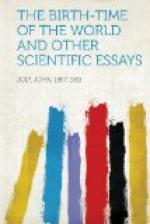173
lines would be formed with great probability under certain conditions, which conditions are themselves probable, then the argument by exclusion for the existence of civilisation on Mars, at once breaks down.
{Fig. 10}
As a romance writer is sometimes under the necessity of transporting his readers to other scenes, so I must now ask you to consent to be transported some millions
174
of miles into the region of the heavens which lies outside Mars’ orbit.
Between Mars and Jupiter is a chasm of 341 millions of miles. This gap in the sequence of planets was long known to be quite out of keeping with the orderly succession of worlds outward from the Sun. A society was formed at the close of the last century for the detection of the missing world. On the first day of the last century, Piazzi—who, by the way, was not a member of the society—discovered a tiny world in the vacant gap. Although eagerly welcomed, as better than nothing, it was a disappointing find. The new world was a mere rock. A speck of about 160 miles in diameter. It was obviously never intended that such a body should have all this space to itself. And, sure enough, shortly after, another small world was discovered. Then another was found, and another, and so on; and now more than 400 of these strange little worlds are known.
But whence came such bodies? The generally accepted belief is that these really represent a misbegotten world. When the Sun was younger he shed off the several worlds of our system as so many rings. Each ring then coalesced into a world. Neptune being the first born; Mercury the youngest born.
After Jupiter was thrown off, and the Sun had shrunk away inwards some 20o million miles, he shed off another ring. Meaning that this offspring of his should grow up like the rest, develop into a stable world with the
175
potentiality even, it may be, of becoming the abode of rational beings. But something went wrong. It broke up into a ring of little bodies, circulating around him.
It is probable on this hypothesis that the number we are acquainted with does not nearly represent the actual number of past and present asteroids. It would take 125,000 of the biggest of them to make up a globe as big as our world. They, so far as they are known, vary in size from 10 miles to 160 miles in diameter. It is probable then—on the assumption that this failure of a world was intended to be about the mass of our Earth—that they numbered, and possibly number, many hundreds of thousands.
Some of these little bodies are very peculiar in respect to the orbits they move in. This peculiarity is sometimes in the eccentricity of their orbits, sometimes in the manner in which their orbits are tilted to the general plane of the ecliptic, in which all the other planets move.
The eccentricity, according to Proctor, in some cases may attain such extremes as to bring the little world inside Mars’ mean distance from the sun. This, as you will remember, is very much less than his greatest distance from the sun. The entire belt of asteroids—as known—lie much nearer to Mars than to Jupiter.




